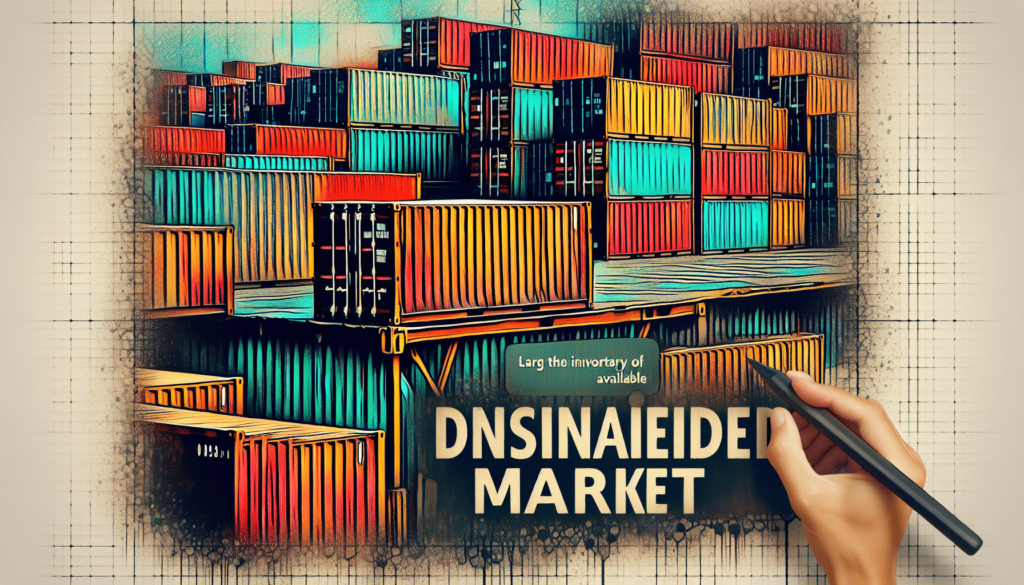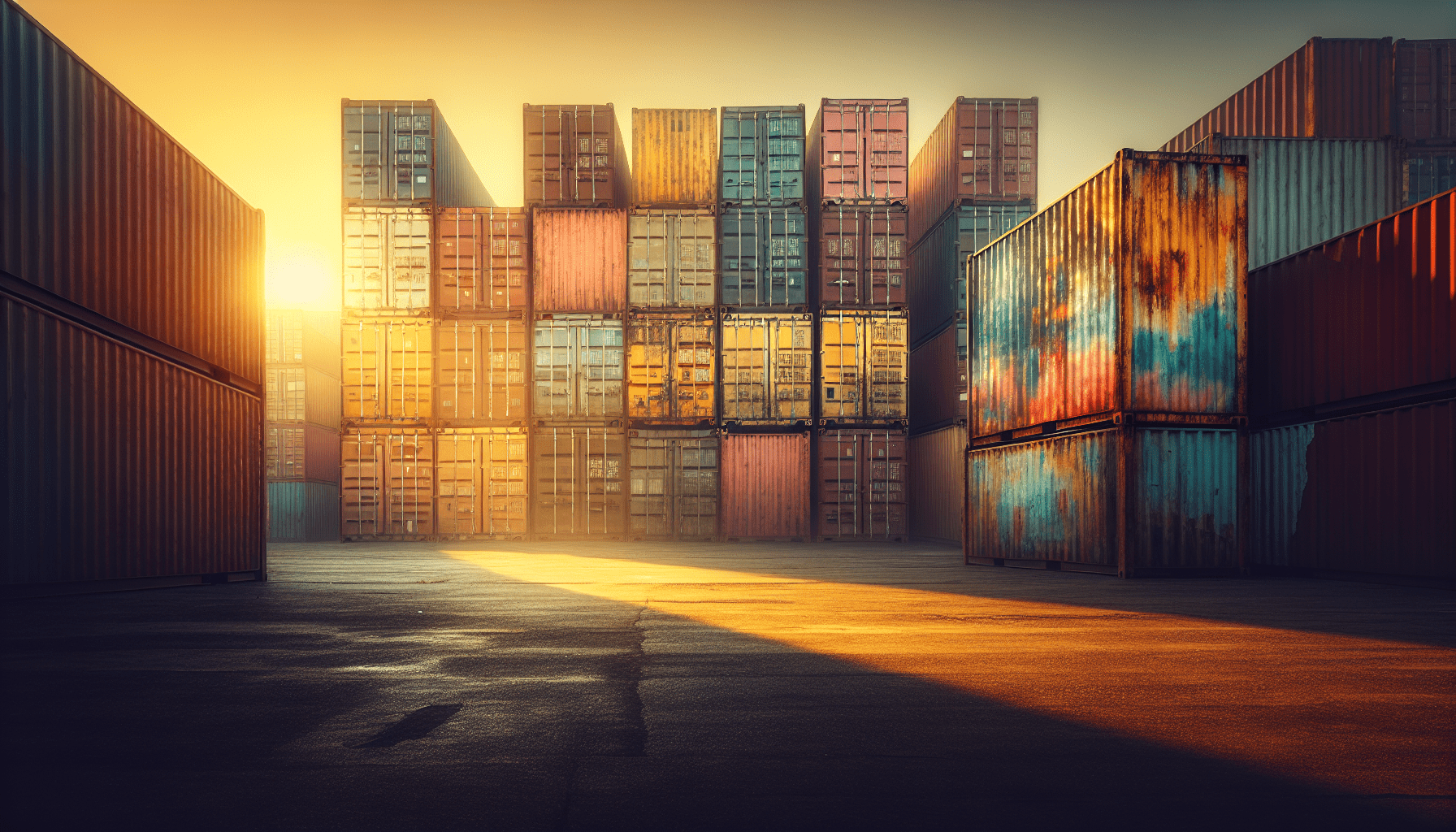Are you in the market for a used shipping container? If so, you might be excited to learn that prices for these versatile units are steadily declining. With the increase in global trade and the growing demand for shipping containers, it’s no wonder that many companies and individuals are seeking affordable options. Whether you’re looking for extra storage space or considering a unique building project, the decreasing prices of used shipping containers offer a promising opportunity to snag a great deal. In this article, we will explore the factors contributing to the drop in prices and what it means for those in need of these durable and cost-effective containers.

Factors Affecting Used Shipping Container Prices
Supply and Demand
The prices of used shipping containers are significantly influenced by the basic economic principle of supply and demand. When the demand for used containers exceeds the available supply, prices tend to rise. Conversely, when the supply of used containers surpasses the demand, prices tend to decrease. Factors such as economic growth, international trade patterns, and geopolitical shifts can impact the demand for shipping containers, thus affecting their prices.
Condition of the Container
The condition of a used shipping container is a crucial determinant of its price. Containers that are in excellent condition, with minimal signs of wear and tear, usually command higher prices compared to those that have visible damages or rust. Prospective buyers often seek containers that are structurally sound, free from leaks, and have intact flooring and door seals. Containers in poor condition may require extensive repairs, which can add to the overall cost and lower their market value.
Size and Type of Container
The size and type of shipping container also play a vital role in determining its price. Standard-sized containers, such as 20-foot and 40-foot containers, are more readily available in the market and generally come at a lower price compared to specialized containers. Specialized containers designed for specific cargo needs, such as refrigerated or open-top containers, tend to be priced higher due to their specialized features and limited availability.
Location and Transport Costs
The location of the container and associated transport costs can affect its price. If a container is located in a remote area with limited access to transportation infrastructure, the costs of transportation to the buyer’s desired location can be substantial. On the other hand, containers situated in shipping hubs or areas with excellent connectivity may have lower transport costs, making them more appealing to potential buyers. The proximity of the container to major transportation routes and ports also influences its price.
Seasonality
Another factor impacting used shipping container prices is seasonality. Seasonal fluctuations in demand can lead to price variations throughout the year. For example, during peak construction and renovation seasons, there is typically an increase in the demand for containers, resulting in higher prices. Similarly, agricultural cycles and trade patterns can influence price fluctuations as well. Understanding the seasonal trends and anticipating price changes can be advantageous for buyers looking for the best deals.
Trends in Used Shipping Container Prices
Decreasing Average Prices
In recent years, there has been a noticeable trend of decreasing average prices for used shipping containers. This can be attributed to several factors, including an increase in the supply of containers due to growing trade volumes and the scaling of container manufacturing. Additionally, competition among suppliers has intensified, leading to price reductions as sellers strive to attract customers. The decrease in average prices has made used shipping containers more affordable and accessible to a wider range of buyers.
Regional Price Variations
While there is a general trend of decreasing average prices, it is important to note that there are regional variations in used shipping container prices. Factors such as local supply and demand dynamics, transportation costs, and the availability of container hubs can contribute to regional price variations. Areas with high demand and limited supply may experience higher prices compared to regions with surplus container inventory. Therefore, buyers should consider these regional variations when searching for the most cost-effective options.
Price Stability
Despite the decreasing average prices, used shipping container prices have demonstrated remarkable stability over time. This stability can be attributed in part to the durable nature of containers and their ability to withstand multiple trips across the globe. The robustness of containers ensures that even older units can still serve their intended purposes, reducing the need for frequent replacements. As a result, prices tend to remain relatively steady, providing buyers with a sense of predictability in their investment.
Predictions for the Future
Looking ahead, experts predict a continued decrease in used shipping container prices, albeit at a slower pace. Factors such as technological advancements in container manufacturing, the development of alternative housing solutions, and sustainable and eco-friendly initiatives are expected to further drive down prices. However, it is important to note that unforeseen events or shifts in global trade dynamics can disrupt these predictions. Continuous monitoring of market trends and industry developments will be essential for buyers seeking the best deals in the future.
Supply and Demand Dynamics
Global Trade Fluctuations
Global trade fluctuations have a significant impact on the supply and demand dynamics of used shipping containers. Changes in international trade patterns, such as shifts in import and export volumes, can directly influence the demand for containers. Economic factors, geopolitical developments, and trade agreements can all contribute to these fluctuations, leading to corresponding fluctuations in container prices. Staying informed about global trade trends is crucial for buyers to anticipate demand fluctuations and make informed purchasing decisions.
Shipping Industry Trends
Trends in the shipping industry have a direct influence on the supply and demand for used shipping containers. For example, a surge in containerization, where more goods are transported in containers rather than traditional methods, can increase the demand for containers. Conversely, advancements in logistics and supply chain management that reduce the need for excessive container usage can impact the demand. Understanding the evolving dynamics of the shipping industry can provide valuable insights for buyers seeking to navigate changes in container prices.
Alternative Uses for Shipping Containers
The increasing popularity of repurposing shipping containers for various applications outside of shipping has contributed to changes in the supply and demand dynamics. From affordable housing and pop-up stores to mobile offices and storage units, repurposed containers offer versatile solutions for a wide range of industries. The demand for containers by these alternative sectors can influence overall supply availability and potentially impact prices. Monitoring the growing trend of container repurposing can provide valuable insights into demand dynamics.
Emerging Markets’ Influence
Emerging markets play a significant role in shaping the supply and demand dynamics of used shipping containers. As economies in emerging markets grow, the demand for goods and commodities increases, resulting in higher container usage. This increased demand can lead to a tightening supply of containers in those markets, potentially driving up prices. Conversely, fluctuations in emerging market economies, such as recessions or political instability, can impact demand, resulting in price variations. Observing the economic trends and trade patterns in emerging markets is crucial for understanding container price dynamics.
Condition of the Container
New vs. Used Containers
The decision between purchasing a new or used shipping container can significantly impact the price. New containers generally come at a higher price due to their pristine condition and lack of wear and tear. However, for buyers who prioritize cost-effectiveness, used containers offer a more affordable option. It is important to assess the specific requirements of the intended use and consider the trade-offs between cost and condition when making a purchasing decision.
Impact of Wear and Tear
The wear and tear on a used shipping container can affect its price. Containers with minimal signs of wear, such as minor scratches or dents, are usually priced higher than those with extensive damage. Structural integrity, absence of leaks, intact flooring, and functional door seals are key factors buyers consider when evaluating the condition of a used container. Containers with excessive wear and tear may require costly repairs or pose risks of compromising the cargo transported inside. Assessing the level of wear and tear is crucial to ensure value for money.
Certifications and Inspections
Certifications and inspections can provide assurance of a used container’s quality and condition, consequently influencing its price. Containers that have undergone thorough inspections and obtained relevant certifications, such as the International Convention for Safe Containers (CSC) certification, often command higher prices. These certifications serve as indicators of compliance with industry standards and safety regulations. Buyers seeking containers for sensitive cargo or long-term use may prioritize certified and inspected units to mitigate potential risks.
Rehabilitation and Modification Costs
Apart from the initial purchase price, buyers should consider the potential costs of container rehabilitation and modification when evaluating their investment. If a used container requires repairs, such as fixing rusted areas or replacing damaged parts, additional costs may be incurred. Similarly, modifying a container to suit specific needs, such as adding doors or windows, can also impact the overall cost. Buyers should factor in these potential expenses to accurately assess the total investment required for the desired container condition and modifications.

Size and Type of Container
Standard vs. Specialized Containers
Used shipping container prices vary based on their size and type. Standard-sized containers, such as the popular 20-foot and 40-foot options, are more readily available in the market and therefore generally come at a lower price. On the other hand, specialized containers designed for specific cargo needs, such as refrigerated or open-top containers, tend to be priced higher due to their specialized features and limited availability. Factors such as cargo requirements and availability of specific container types should be considered when evaluating the price-value proposition.
Common Sizes and Prices
Standard-sized containers, specifically 20-foot and 40-foot containers, are widely used and therefore more affordable compared to less common sizes. The average price of a used 20-foot container ranges between $1,500 and $3,500, depending on factors such as condition, location, and demand. Similarly, a used 40-foot container generally falls within the price range of $2,000 to $6,000. Buyers seeking cost-effective options should consider these common sizes, as they offer a good balance between affordability and availability.
Specialized Container Demand
Containers designed for specialized purposes, such as refrigerated containers for perishable goods or open-top containers for oversized cargo, often have specific requirements that can impact their price. The demand for these specialized containers is influenced by industries such as agriculture, pharmaceuticals, and construction, among others. Buyers seeking specialized containers should be aware that availability may be limited, and prices may be higher due to the specific features and unique demand within these niche industries.
Price Variations by Container Type
Different types of containers can have varying price ranges based on factors such as demand, availability, and specialized features. For example, refrigerated containers commonly used for transporting temperature-sensitive goods tend to have higher prices due to their complex cooling systems and limited supply. In contrast, dry storage containers, which are the most common type, typically have lower prices due to their widespread availability. Buyers should consider the specific requirements of their cargo and understand the price variations associated with different container types.
Location and Transport Costs
Shipping Container Hubs
The location of shipping container hubs can influence their prices. Major ports and transportation hubs with high container traffic tend to have larger inventories of used shipping containers, leading to increased supply and competitive pricing. Areas with a dense concentration of shipping activities, such as coastal cities or major trade routes, are more likely to have a surplus of containers available for purchase. Identifying such container hubs and understanding their pricing dynamics can be advantageous for buyers seeking affordable options.
Availability in Local Markets
The availability of used shipping containers in local markets can impact their prices. Markets with a higher demand for containers relative to supply may experience higher prices due to increased competition among buyers. Conversely, markets with surplus container inventory may offer more competitive pricing as sellers aim to clear their stock. Buyers should assess the availability of containers in their local markets and explore neighboring regions if prices are deemed unfavorable in their immediate vicinity.
Transportation Costs
Transportation costs from the seller’s location to the buyer’s desired destination can significantly impact the overall price of a used shipping container. Factors such as the distance between the two locations, the mode of transportation (road, rail, or sea), and any logistical complexities can influence the cost of transporting the container. Containers located closer to the buyer’s desired destination may incur lower transportation costs, making them more cost-effective options. Buyers should consider the transportation costs in their budget when evaluating the total investment required for a used shipping container.
Cross-border Trade Considerations
Cross-border trade can introduce additional costs and complexities to the purchase of used shipping containers. Import duties, customs fees, and compliance with international regulations can impact the overall price of containers transported across national borders. Buyers involved in international trade should consider these additional expenses and ensure compliance with relevant regulations to accurately assess the total cost of acquiring a used shipping container. Consulting with freight forwarders or trade experts can help navigate the complexities of cross-border trade and minimize unexpected costs.
Seasonality in Pricing
Peak and Off-peak Demand
Seasonality plays a significant role in used shipping container pricing due to variations in demand throughout the year. Certain periods, such as the spring and summer months, often experience peak demand for containers due to increased construction and renovation activities. During these peak seasons, prices may be higher as demand exceeds supply. Conversely, off-peak seasons, such as the winter months, may see a decrease in demand, leading to lower prices. Buyers who can time their purchases during off-peak seasons may be able to secure more favorable pricing.
Construction and Renovation Seasonality
Seasonal fluctuations in construction and renovation activities can influence demand for used shipping containers. The construction industry tends to be more active during the spring and summer months when weather conditions are favorable for outdoor work. During these seasons, contractors and builders require containers for various purposes, such as on-site storage or temporary offices. The higher demand during peak construction and renovation periods can lead to increased container prices. Buyers involved in the construction industry should consider these seasonal factors when planning container purchases.
Agricultural and Trade Cycles
Agricultural cycles and trade patterns can affect the seasonality of used shipping container prices. In agricultural regions, for example, the harvest season often demands containers for transporting crops. The timing of these harvest seasons can lead to fluctuations in container prices as demand rises. Trade cycles, such as the holiday season or periods of increased consumer spending, can also impact container prices due to higher demand for imported goods. Buyers involved in agriculture or trade-dependent industries should be mindful of these seasonal price variations.
Impact on Prices
Seasonality directly impacts the supply and demand dynamics of used shipping containers, resulting in price variations throughout the year. Buyers must consider these seasonal fluctuations when planning their container purchases to take advantage of more favorable prices during off-peak periods. Understanding the specific needs of different industries and their seasonal demands can provide valuable insights into when and where to find the best deals on used shipping containers.
Impact of Industry Developments
Technological Advancements
Technological advancements within the shipping industry can have both direct and indirect impacts on used shipping container prices. Advancements in container tracking systems, for example, can improve container management and reduce the risk of loss or theft. This increased security may contribute to a decrease in insurance costs for containers, indirectly influencing their overall prices. Similarly, innovations in container manufacturing processes can lower production costs, potentially leading to price reductions. Keeping up with technological developments can provide useful insights into ongoing price trends.
Sustainable and Eco-friendly Initiatives
Growing environmental consciousness and sustainability efforts are influencing the shipping industry and, subsequently, used shipping container prices. Sustainable initiatives, such as using more eco-friendly materials or repurposing containers for alternative purposes, are becoming increasingly popular. Consequently, containers that align with these eco-friendly practices may attract higher demand and command higher prices. Buyers interested in sustainable solutions should consider these initiatives when evaluating container prices and prioritize environmentally friendly options.
Alternative Housing Solutions
The emergence of alternative housing solutions, such as container homes or modular housing, has impacted the market for used shipping containers. The demand for containers suitable for converting into affordable housing units has increased, leading to price variations. Containers that meet the specific requirements for housing conversions, such as structural integrity, proper insulation, and easy modification capabilities, may command higher prices. Buyers interested in container housing projects should closely follow trends in this sector to understand their implications on container prices.
Influencing Prices
Industry developments, such as technological advancements, sustainability initiatives, and the rise of alternative housing solutions, can exert varying influences on used shipping container prices. These factors can either directly impact container prices through changes in manufacturing costs or indirectly influence prices by affecting demand dynamics. By staying informed about industry developments, buyers can anticipate potential price fluctuations and align their purchasing strategies accordingly.
Factors Driving Price Decrease
Increased Availability
The increased availability of used shipping containers is a primary driver of the ongoing price decrease. The growth in international trade and scaling of container manufacturing has contributed to a surplus of containers in the market. This surplus has created a more competitive environment among sellers, resulting in downward pressure on prices. The widening availability of used containers allows buyers to choose from a larger pool of options and potentially negotiate more favorable prices.
Competition among Suppliers
The intensifying competition among suppliers is an influential factor driving the decrease in used shipping container prices. As the market becomes more saturated with sellers, suppliers are vying for customers by offering competitive pricing. This competition prompts sellers to continually reassess and adjust their pricing strategies to attract buyers. Buyers can take advantage of this competitive landscape by comparing prices from different sellers and negotiating for better deals.
Scaling of Container Manufacturing
The scaling of container manufacturing has contributed to the decrease in prices for used containers. The growth of global trade and the demand for new containers have led manufacturers to increase production capacities. As a result, more new containers are entering the market, diverting some demand away from the used container market. This increased supply of new containers puts downward pressure on the prices of used containers as sellers offer competitive pricing to attract buyers.
Shift in Market Dynamics
Shifts in market dynamics, including changes in global trade patterns and economic conditions, are instrumental in driving the price decrease of used shipping containers. Economic downturns or recessions can lead to reduced trade volumes and lower demand for containers, consequently impacting their prices. Additionally, geopolitical shifts or changes in trade agreements can influence trade routes and patterns, altering the demand for containers in specific regions. Monitoring these market dynamics is crucial for understanding the direction of container prices.
Conclusion
Used shipping container prices are influenced by various factors such as supply and demand dynamics, the condition of the container, size and type, location and transport costs, seasonality, and industry developments. The recent trend of decreasing average prices is driven by factors such as increased availability, competition among suppliers, scaling of container manufacturing, and shifts in market dynamics. Buyers should consider these factors and monitor industry trends to make informed decisions and navigate the market effectively. Understanding the impact of these factors on used shipping container prices is essential for various industries and individuals seeking cost-effective solutions.

I am James, the creator behind SeaBoxInnovations.com. Welcome to our premier online destination dedicated to the world of sea containers. Think Inside the Box is our tagline, and our website is your go-to source for exploring the endless potential of these versatile and adaptable containers. Whether you’re interested in purchasing, customizing, or learning about the latest trends in container architecture and design, we have you covered. Join us as we bridge the gap between traditional uses and cutting-edge applications, promoting sustainability and innovation in design and construction. Get ready to embark on your next big project with SeaBoxInnovations.com.

